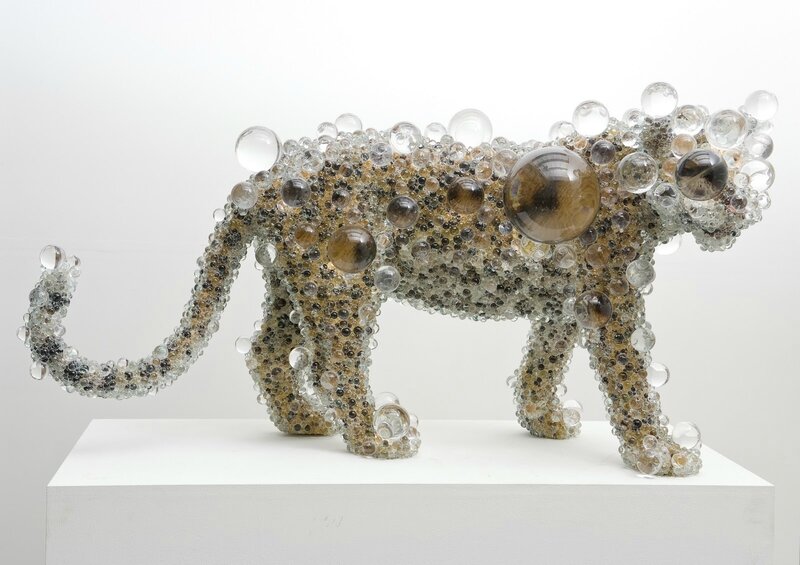Nawa Kohei (B. 1975), Pixcell-Model-Leopard, 2009
Lot 1079. Nawa Kohei (B. 1975), Pixcell-Model-Leopard, executed in 2009, mixed media, work: 80 (H) by 148 by 84 cm; 31½ (H) by 58¼ by 33 in. Estimate 1,500,000 — 2,500,000 HKD. Photo Sotheby's
Provenance: SCAI THE BATHHOUSE, Tokyo
Acquired by the present owner from the above
Crystalline Illuminations
Nawa Kohei
Art as self-expression has been already over-exploited by former generations. I think we're heading for a different type of art.-- Nawa Kohei
PixCell-Model-Leopard (Lot 1079) is the first leopard from Nawa Kohei’s extraordinary PixCell series ever to emerge at international auction. Ensconced entirely in glittering orbs of crystal glass, the toy leopard is transformed into an exquisite otherworldly creature that seems to hover weightlessly like an ephemeral mirage. The artist first conducts an extensive search for his desired object from various internet sources. He then acquires the object and adorns it in crystal beads of varying sizes, painstakingly mapping out the specific location of each individual sphere. “There is no arbitrariness to this method”, the artist notes in a catalogue for his exhibition at the Museum of Contemporary Art Tokyo in 2011. The different sized orbs reflect, morph and mutate the textures of the animal in enthralling ways, resulting in infinite magnifying and distorting lens that create an alluring visual experience.
Nawa’s internationally esteemed and highly representative PixCell series was developed over the course of more than a decade. The first prototype, a series of glass-covered taxidermy deer, captivated audiences at Scai the Bathhouse in Tokyo in 2010. The aesthetically and conceptually sophisticated sculptures sought to destabilize the phenomenon of human sense and perception, reminding viewers of the ambiguity that underlies their relation between truth and reality. At the same time Nawa engages critically with the nature of taxidermy: according to the artist, when we doubt our realities and find cause to question it, we struggle to ‘possess’ truth and certainty much in the same way taxidermy ‘possesses’ or ‘captures’ movement. Be it taxidermy deer or toy leopard, ensconcing the animal under glass beads destabilizes our ability to ‘store’ the object, blurring our understanding and perception.
The series’ name ‘PixCell’ is an amalgamation of the words ‘pixel’, which describes digital image resolution, and the biological ‘cell’—the simplest forms of both the digital and organic worlds. Finding inspiration in life’s tiniest building blocks, Nawa puts forth a shrewd commentary on the contemporary world’s obsession with viewing and filtering the world through pixels—via cameras, smartphones and surveillance technology—which both distorts and illuminates the world we live in. The fact that he first encounters the objects he eventually works on as an image on the internet is significant; as the artist explains in an interview: “At [the initial] stage I first encounter the motif as an image (a group of pixels) appearing on the computer screen. I then acquire the actual object and give it a skin of a large, indeterminate number of cells”.1 Re-constructing virtual image as actual skin, Nawa’s PixCell series interrogates the binaries between form and content, interior and exterior, vision and touch and illusion and truth. In equal parts contemplative and iridescently mesmerizing, PixCell constitutes a truly iconic magnum opus in 21st century contemporary art.
1 Nawa Kohei, quoted in “Kohei Nawa: A Japanese Artist Beyond Cultural Stereotypes”, Digicult, 2015
Sotheby's. Modern and Contemporary Asian Art Evening Sale, Hong Kong, 02 oct. 2016, 05:00 PM

/https%3A%2F%2Fprofilepics.canalblog.com%2Fprofilepics%2F1%2F0%2F100183.jpg)
/https%3A%2F%2Fstorage.canalblog.com%2F03%2F02%2F119589%2F96711876_o.jpg)
/https%3A%2F%2Fstorage.canalblog.com%2F11%2F31%2F119589%2F94773502_o.jpg)
/https%3A%2F%2Fstorage.canalblog.com%2F20%2F83%2F119589%2F94772815_o.jpg)
/https%3A%2F%2Fstorage.canalblog.com%2F26%2F72%2F119589%2F75604929_o.jpg)
/https%3A%2F%2Fstorage.canalblog.com%2F59%2F60%2F119589%2F26458628_o.jpg)




/http%3A%2F%2Fstorage.canalblog.com%2F08%2F01%2F119589%2F112744193_o.jpg)
/http%3A%2F%2Fstorage.canalblog.com%2F41%2F79%2F119589%2F112274718_o.jpg)
/http%3A%2F%2Fstorage.canalblog.com%2F78%2F32%2F119589%2F110500510_o.jpg)
/http%3A%2F%2Fstorage.canalblog.com%2F60%2F81%2F119589%2F110394804_o.jpg)